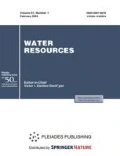Abstract
The possible input of nutrients-pollutants into water bodies in the Upper Volga basin from agricultural lands is evaluated for the case of the Yakhroma R. with a basin area of 1437 km2. Water quality was studied along river profile to show that the sources of nutrient pollution, in addition to wastewaters from the cities of Dmitrov and Yakhroma, are agricultural lands on the water divide and a melioration object in the floodplain >9 thousand ha in area. The input of nitrogen, phosphorus, and potassium with surface and drainage water into river network was evaluated. It was shown that the major pollutants of either surface or drainage waters are nitrogen and potassium compounds and, to a lesser extent, phosphorus compounds. The overall normal annual volume of surface runoff in the Yakhroma basin was evaluated at 12 358 thousand m3 and that of drainage water at 15952 thousand m3. The export of nitrogen, phosphorus, and potassium with surface runoff is 27.36, 6.06, and 242.28 t/year, respectively; the respective values for drainage runoff are 96.88, 0.38, and 37.04 t/year. Scenarios of protection measures were developed to reduce the pollution of surface water and to clean drainage water of nitrogen and phosphorus compounds by reducing the nutrient pollution of the river by 73.7 t/year in the case of surface runoff regulation and by 160 t/year, in the case of drainage runoff treatment.




Similar content being viewed by others
REFERENCES
Vagner, B.B., Reki i ozera Podmoskov’ya (Rivers and Lakes of the Moscow Region), Moscow: Veche, 2006.
Gosudarstvennyi doklad “O sostoyanii i ob okhrane okruzhayushchei sredy Rossiiskoi Federatsii v 2016 godu” (State Report “On the State and Protection of the Environment in the Russian Federation in 2016”), Moscow: Minprirody Rossii, NIA-Priroda, 2017.
Kireycheva, L.V., Drenazhnye sistemy na oroshaemykh zemlyakh: proshloe, nastoyashchee, budushchee (Drainage Systems in Irrigated Lands: The Past, Present, and Future), Moscow: ROMA, 1999.
Kireycheva, L.V., Yurchenko, I.F., and Yashin, V.M., Models and information technologies of water use management in melioration systems ensuring favorable melioration regime, Melior. Vodn. Khoz. (Moscow, Russ. Fed.), 2014, no. 5, pp. 50–55.
Komarov, I.K., Vozrozhdenie Volgi shag k spaseniyu Rossii (Restoration of the Volga as a Step to Saving Russia), Moscow, Nizhny Novgorod: Ekologiya.
Komparskas, I.I., On the regime of nutrient leaching by drainage flow in drained mineral soils, Trans. Lit. Res. Inst. Gidrot. Melior., 1966.
Kreier, K.G., Formation specifics of soil lysimetric solutions in sod-podzol soils and their possible role in plant nutrition, in Plodorodie pochv i pitanie rastenii (Soil Fertility and Plant Nutrition), Leningrad, 1973.
Kuznetsova, N.V., The present-day hydrobiological conditions of the Yakhroma River as a model small river in the Moscow Region, Cand. Sci. (Biol.) Dissertation, Moscow: Russian Federal Research Institute of Fisheries and Oceanography, 2015.
Metodika opredeleniya predotvrashchennogo ekologicheskogo ushcherba. Utv. v 1999 g. Prikaz Goskomekologii RF ot 30.12.1999 g. № 816 (Procedure for Determining Prevented Ecological Losses, Approved in 1999. Order of RF Goskomekologiya of December 30, 1999 no. 816).
Rekomendatsii po raschetu sistem sbora, otvedeniya i ochistki poverkhnostnogo stoka s selitebnykh territorii. ploshchadok predpriyatii i opredeleniyu uslovii vypuska ego v vodnye ob’’ekty (Recommendations for Calculating the Systems of Collection, Diversion, and Treatment of Surface Runoff from Residential Territories and Industrial Sites and Determining the Conditions for Its Release into Water Objects), Moscow: NII VODGEO, 2015.
Rukovodstvo po opredeleniyu raschetnykh kontsentratsii mineral’nykh, organicheskikh veshchestv i pestitsidov v drenazhnom i poverkhnostnom stoke s melioriruemykh zemel’. VTR-P-30-81 (Guide for Evaluating the Concentrations of Mineral and Organic Substances and Pesticides in Drainage and Surface Flow from Meliorated Lands), Moscow: Approved by an Order of USSR Minvodkhoz no. 276 of June 22, 1981.
Tomson, Kh. and Khonnolainen, G.O., On the export of nutrients by drainage flow from heavy sod-gley soils in the cultivation of winter wheat, Sb. Nauch. Tr. EstNII Zemled. Melior., 1973, no. 29.
Fedotova, Z.D. and Strautynya, V.P., Nutrient export by drainage flow from drained soils, Elgava, Tr. LatNIIGiM, 1969, no. 9, pp. 43–47.
Khrisanov, N.I. and Osipov, G.K., Evtrofirovanie vodoemov (Eutrophication of Water Bodies), St. Petersburg: Gidrometeoizdat, 1993.
Shavliashvili, L.U., Studying the effect of fertilizers and toxic chemicals on the chemistry of natural water and soils in excessively moistened regions of Western Georgia, in Sb. tr. VIII Mezhdunar. Kongressa po mineral’nym udobreniyam (Proc. VIII Intern. Congr. on Mineral Fertilizers), Tbilisi, 1976.
Shkinkis, Ts.N., Problemy gidrologii drenazha (Problems of Drainage Hydrology), Leningrad: Gidrometeoizdat, 1974.
Shkinkis, Ts.N., Gidrologicheskoe deistvie drenazha (Hydrological Effect of Drainage), Leningrad: Gidrometeoizdat, 1981.
Ekologicheskie problemy Verkhnei Volgi: Kollektivnaya monografiya (Ecological Problems of the Upper Volga: A Multi-Author Book), Yaroslavl: Yarosl. Gos. Techn. Univ., 2001.
Yashin, V.M., Pollution of drainage flow from meliorated floodplains, Naukoemkie tekhnologii v melioratsii (Kostyakovskie chteniya). Mezhdunarod. konf. (Science-Intensive Technologies in Melioration (Kostyakov Readings)), Moscow, 2005, pp. 457–463.
Yashin, V.M., Formation of drainage flow quality in the Yakhroma floodplain, Melior. Vodn. Khoz. (Moscow, Russ. Fed.), 2017, no. 6, pp. 21–26.
Betson, R.P. and McMaster, M., Non-point source mineral water quality model, J. Water Pollut. Contr. Fed., 1975, vol. 47, no. 10, p. 42.
Hock, B., Water quality balance, Technical and economic water management series VMGT, Budapest: VIZDOK Press, 1970, no. 27, p. 124.
Maidment D.R., Handbook of Hydrology, New York: McGrow-Hill Inc, 1992.
O’Brien, W.G., et al., Modeling discharge and conservative water quality in the Lower Kansas River basin, Univ. of Kansas, 1972, Bull. 204, Pt. 3, p. 153.
Author information
Authors and Affiliations
Corresponding author
Additional information
Translated by G. Krichevets
Rights and permissions
About this article
Cite this article
Kireycheva, L.V., Lentyaeva, E.A., Timoshkin, A.D. et al. The Assessment of the Diffuse Pollution from Agricultural Territories in the Upper Volga Basin and the Development of Measures to Reduce It: Case Study of the Yakhroma River. Water Resour 47, 709–720 (2020). https://doi.org/10.1134/S0097807820050097
Received:
Revised:
Accepted:
Published:
Issue Date:
DOI: https://doi.org/10.1134/S0097807820050097




